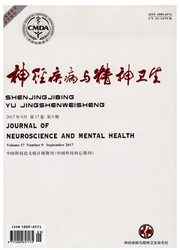

 中文摘要:
中文摘要:
目的探讨酸感受离子通道(ASICs)、钠氢泵(NHE)基因表达及其在痫性发作中的作用。方法联合运用脑电图及逆转录PCR方法,检测正常大鼠,匹鲁卡品致痫大鼠,阿米洛利海马ASIC1a,ASIC3及NHErnRNA表达。结果痫性发作1h即可观察到ASIC1a,ASIC3及NHEmRNA表达较正常大鼠增加,差异具统计学意义(P〈0.01);痫性发作大鼠给予阿米洛利后,与对照组(痫性发作1h组)相比,ASIC1a,ASIC3mRNA表达差异有统计学意义(P〈0.01),NHEmRNA表达差异无统计学意义(P〉0.05)。结论痫性发作可致ASIC1a,ASIC3基因表达增加,抑制AslC1a,ASIC3基因可减弱痫性发作,而与时NHE的作用无关。
 英文摘要:
英文摘要:
Objective To investigate the effect of acid senor ion channels (ASICs) and Na+/H+ exchanger (NHE) gene expression in seizure attack. Methods Using electroencephalogram and RT-- PCR, to detect the correlation of seizure attack and ASICs/NHE gene expression in normal, seizure and amiloride--treated rats. Results Compared with the control group, ASIC la and ASIC 3 gene expres- sion increased in the rat hippocampal after 1 h and 2 h seizure attacking (P 〈 0. 01). Compared with the lh seizure group, ASIC la and ASIC 3 gene expression decreased significantly in the rat hippocampal ap- plied with amiloride after seizure attacking (P 〈 0.01). Compared with the control group, Na+/H + exchanger (NHE) gene expression increased in the rat hippocampal after 1 h and 2h seizure attacking (P 〈 0.01). Compared with the lh seizure group, there's no difference of NHE gene expression in the rat hippocampal applied with amiloride after seizure attacking (P 〉 0.05). Conclusions Seizure attac- king leads to elevation of ASIC la and ASIC 3 gene expression, amiloride decreased ASIC la and ASIC 3 gene expression which may inhibit and seizure attacking.
 同期刊论文项目
同期刊论文项目
 同项目期刊论文
同项目期刊论文
 期刊信息
期刊信息
